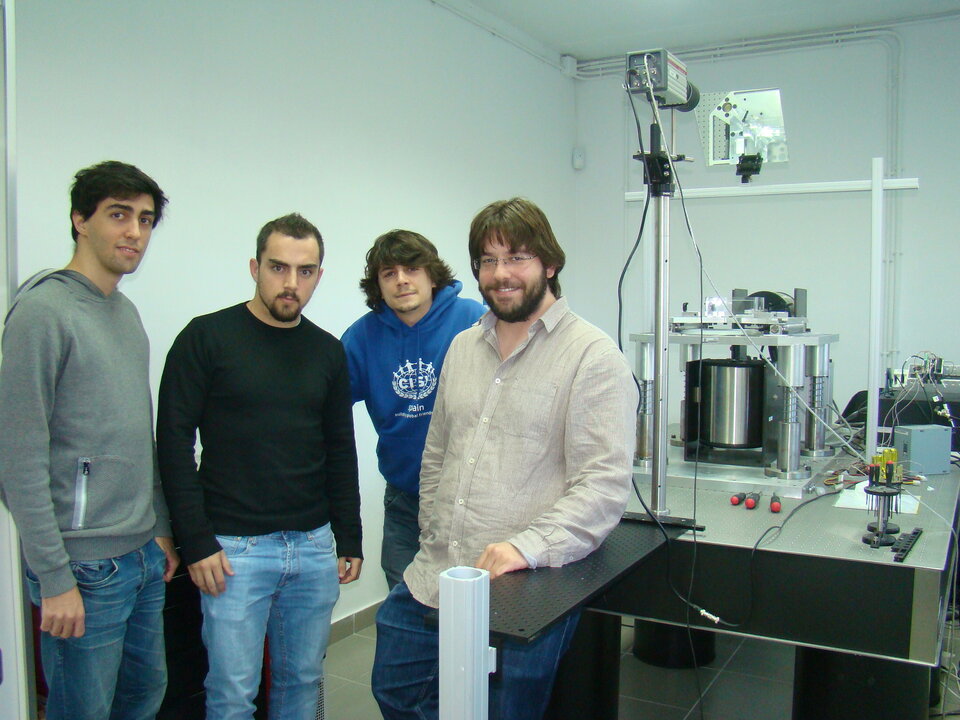Meet the teams: CFVib
The CFVib team, which is affiliated with the Escuela Técnica Superior de Ingeniería Aeronáutica y del Espacio at the Universidad Politécnica de Madrid, has been selected to design, build and operate a fluid science experiment that will investigate the complex behavior of liquids under high frequency vibration in a weightless environment, and evaluate the potential of small amplitude excitations for controlling and managing liquids in space.
Control of Fluids in Microgravity with Vibrations (CFVib)![]()
| University | Escuela Técnica Superior de Ingeniería Aeronáutica y del Espacio, Universidad Politénica de Madrid, Spain |
| Endorsing professor |
Jeff Porter Ignacio Tinao Universidad Politénica de Madrid, Spain |
| ELGRA mentor |
Ricard González-Cinca Department of Applied Physics at Universitat Politècnica de Catalunya-BarcelonaTech (UPC) |
| Team |
José Javier Fernández Fraile Pablo Salgado Sánchez Álvaro Olivares del Bosque Ignacio Carrera Calvo |

The CFVib team has designed and proposed an experiment to fly in the autumn 2016 Novespace parabolic flight campaign promoted by ESA’s Fly your Thesis! programme.
There are special challenges associated with managing fluids in space, something that is required, for example, in life-support and propulsion systems. In particular, it is important to understand the effects of the small vibrations, often called g-jitter, that come to the fore in the absence of a strong gravitational field. These may be due to on-board machinery, crew movements, orbit and docking manoeuvres, etc., and are problematic for scientific experiments that assume a zero gravity condition. Furthermore, without a strong gravitational field to pull fluids down, surface forces dominate, leading to more complex static configurations even in the absence of g-jitter. Depending on the fluid, container, and their surface properties, multiple solutions may coexist, especially in non-wetting systems where disconnected (partial) volumes of fluid can be established. The relatively large energy barrier between these states means that hysteresis will be much more prominent than it is in ordinary gravity.
A fluid mass with at least one free boundary will generally respond to vibrations via surface motion (waves) oscillating on the same timescale as the vibrational forcing. In addition to this more familiar response, vibrations induce a slow reorientation of the (average) fluid position toward a new (quasi-static) equilibrium determined by a balance between surface and vibrational energies. These new surface configurations, which are known as vibroequilibria, may differ substantially from the unforced equilibrium shape.
The CFVib project will make use of piezoelectric devices to vibrate, at high frequency, representative fluid-gas and fluid-fluid configurations confined in relatively small transparent acrylic containers. The induced oscillatory velocity field will drive the reorientation of the fluid interface. The dependence of this vibroequilibria phenomena on control parameters (frequency, amplitude, phase) will be investigated, as well as subsequent instabilities and coupling to other dynamical modes, like sloshing. It is hoped that the results of the project will allow engineers to take advantage of the vibroequilibria phenomenon, in certain systems, to help control and manipulate confined fluids, setting up desired initial conditions for microgravity fluid experiments, for example, or managing fluids in life-support and propulsion systems.
In order to fulfill the experiment objectives the CFVib team is investigating two different container shapes: cylindrical containers that are 3 cm in diameter and 6 cm tall, and cuboid containers with edges 3 cm long. Some experimental containers hold water, some oil, and some a mixture of the two. The piezoelectric devices are attached to the ends of the cylindrical containers and to three of the six sides of the cuboid containers. Forcing frequencies range from tens of kilohertz to megahertz, and a set of cameras record the resulting movement and surface deformation.
Read more about this experiment in this article.

